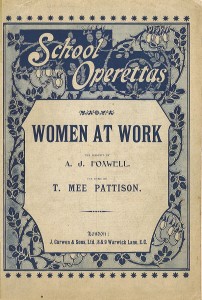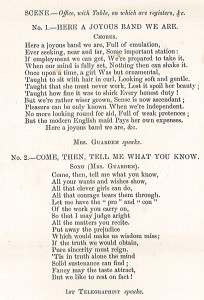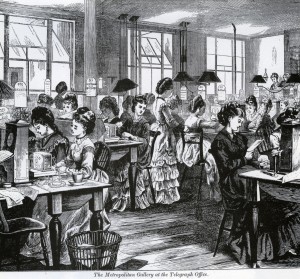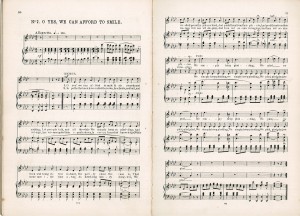The 1886 school operetta, “Women at work”: a new acquisition for Rare Music
 Women at work, an 1886 operetta by Thomas Mee Pattison, with libretto by A.J. Foxwell, is a very rare and rather curious recent addition to the Rare Music collection. 1) It belongs to London publisher J. Curwen & Sons’ extensive series of “school operettas”, themselves evidence of the importance of vocal music in English schools at the time. The series includes short works intended for small children (Fairies of the Seasons, for example) through to extended works for senior students. Clearly one of the latter in its subject matter, Women at work is also one of the very longest, with an estimated duration of 2 ¼ hours.
Women at work, an 1886 operetta by Thomas Mee Pattison, with libretto by A.J. Foxwell, is a very rare and rather curious recent addition to the Rare Music collection. 1) It belongs to London publisher J. Curwen & Sons’ extensive series of “school operettas”, themselves evidence of the importance of vocal music in English schools at the time. The series includes short works intended for small children (Fairies of the Seasons, for example) through to extended works for senior students. Clearly one of the latter in its subject matter, Women at work is also one of the very longest, with an estimated duration of 2 ¼ hours.
Of its two creators, a little is known about T. Mee Pattison (1845–1936), who was born in Warrington, Cheshire and became an organist–choirmaster in his home town, aged 24. In the mid-1880s he moved to London where he composed and published a substantial amount of music, both sacred and secular: cantatas, operettas, anthems, and works for organ and piano. He was successful enough a composer by 1890 for extended extracts from his lecture, “How to write complete musical works” to appear in the Musical World. 2) The identity of his equally prolific and versatile librettist, A.J. Foxwell, is less clear.
It is, however, the subject matter that makes this particular operetta interesting. Women at work is set in the office of a Mrs Guardem who is about to set up an employment agency exclusively for women. Surrounded by women and girls she asks them to tell her all they know about their occupations that she may help place others.
The requirement for only a single stage set—an office with “desk, table, large registers, &c.,”—and the general absence of stage action makes Women at work more a secular cantata than an operetta. There are only a few stage directions that require on-stage movement, notably: “Ladies all surround the Man with exclamations and gestures of disapproval”. Otherwise the work is more a concert in costume, for “each performer should wear the ordinary working dress of the trade or profession she represents” (p. [iii]).
An unusual aspect of Women at work is the contrast between the light and often amusing tone of the lyrics of the twenty-three musical numbers and the relentless didacticism of much of the spoken dialogue that separates them. As an example, the humorous Trio, no. 4, “I’m a clerk”—sung by post-office employees: a clerk, a “sorter” and a “counterwoman”—is followed by a speech from each woman about prerequisites, salary and conditions: a mail sorter, for example, “must be 4ft. 10in. in height, without boots … and know especially the geography of the United Kingdom” (p. 23).
The incorporation of swathes of information may have been common in these senior school cantatas; The sons of toil, published the following year and also created by Pattison and Foxwell, was observed by the Musical World’s critic to have “long-winded” dialogue. 3) Here the reviewer evokes the spirit of “Mr Barlow”—the “instructive monomaniac” created by Charles Dickens around 1860—but goes on to concede that the cantata’s impulse to instruct may be appropriate in a school context.
The librettist had contemporaneous published sources to mine for information; a debt to Mercy Grogan’s How women may earn a living (1880; rev 1883) and the Guide to Female Employment in Government Offices (1884) are two of the sources acknowledged. There is an emphasis in Grogan and in the cantata on “suitable” employment for “genteel” women—the first group of women to sing, for example, are telegraphists (see illustration from 1870)—rather than the hardship of the factory floor. 4) 
In Women at Work, the factory is not mentioned until we hear the Trio, “We are workers in a pottery” (p. 52) followed by short speeches from “Cotton-factory girl” and “Straw worker”. The cantata dates from the beginning of a period when “white collar” employment opportunities for women—clerical and retail work, for example—increased and their employment in manufacturing declined. 5) The typewriter, in use from around 1882, generated what was essentially a new occupation and it was women who took up these stenographer positions in business offices.
The single male character, “Man”, who enters in a “serio-comic style” towards the end of the work (p. 57), is used to change the focus to issues such as the effect on men’s employment prospects of women occupying traditionally male roles; and why women shouldn’t (or couldn’t) simply stay out of the workforce. All is resolved by the cantata’s end, mostly through repeated assertions of the value of hard work for all. And what of the music? Stylistically the music of Women at work often resembles that of the comic operas of his contemporary Arthur Sullivan (1842–1900), the composer from the “Gilbert and Sullivan” partnership.
Looked at in the social and music-educational context of its time, Women at work is an interesting piece and one that would reward further study. And if a willing group of musicians could be assembled, sight reading it through could be both entertaining and instructive.
Jennifer Hill, Music curator
1) Two other copies only have been traced; both in the Bodleian Library, Oxford.
2) Musical World, 18 October 1890: 829.
3) Musical World, 28 May 1887: 412.
4) Alison Kaye, The foundations of female entrepreneurship: Enterprise, home and household (New York: Routledge, 2009), p. 13–14.
5) Louise A. Tilly and Joan W. Scott, Women, work and family (New York: Routledge, 1978, rev. 1987), p. 156–57.
According to the 1911 census Thomas Mee Pattison called himself a Professor of Music. He didn’t seems to make much money from his music as he only had 10 pounds of effects when he died in 1936